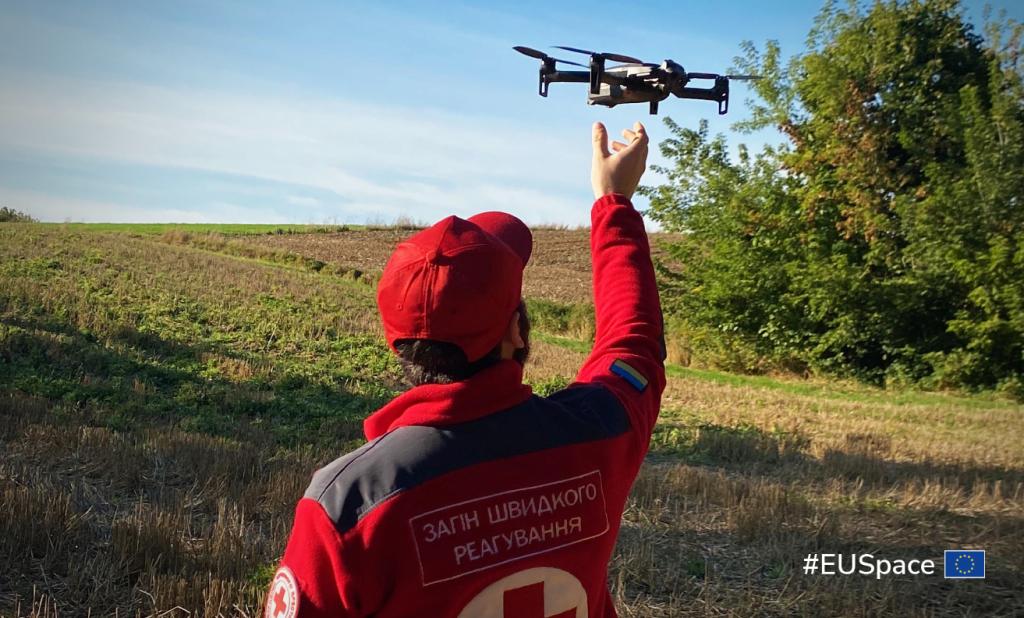EUSpace4Ukraine Demonstrator Day: Enhancing Humanitarian Support for Ukrainian People

In a demonstration of humanitarian synergy, the EU Agency for the Space Programme (EUSPA), alongside the Ukrainian Red Cross and the European innovators Global Smart Rescue and CloudFerro, recently held a demonstrator day in Lublin, Poland within the framework of the EUSpace4Ukraine initiative.
The EUSpace4Ukraine initiative is mobilising the EU Space innovation community that can provide technological solutions to enhance humanitarian support for the Ukrainian people. The recent event served as a platform to present a range of EU Space-enabled solutions, illustrating how innovations can elevate humanitarian aid for Ukraine.
Providing awareness for fieldwork navigation thanks to Copernicus
The first presented demonstrator was the Copernicus enhanced map application, developed with the Polish innovator CloudFerro. The web application provides up-to-date, accurate Copernicus imagery that can be used for mission planning under conditions of destroyed infrastructure or natural disasters, aiding humanitarian workers in navigating challenging terrains faster and more effectively. The presentation led to a discussion on the role of Copernicus in improving fieldwork mission planning and the Ukrainian Red Cross will test this solution in the coming weeks in their fieldwork.
Enhancing Search and Rescue with Galileo
Enabled by Galileo, drones equipped with a thermal camera and optical zoom are invaluable assets for assessing the structural integrity of damaged buildings, searching for people in remote locations, or various other Search & Rescue missions after man-made or natural disasters. In these critical moments, this drone technology can swiftly and precisely navigate even the most challenging terrains, ensuring that help reaches those in distress as fast as possible. This technology will also be thoroughly tested by the Emergency Response Team of the Ukrainian Red Cross in their fieldwork in the coming weeks.
To show the further innovations in urban Search and Rescue tools, the French innovator Global Smart Rescue showcased their geo-locatable “Little Alert Box” - the system uses sensors to detect unusual environmental conditions, ensuring reliable communication even in emergencies. They also presented an advanced solution enabling to geolocate smartphones of individuals in distress (e.g. trapped inside buildings). The Galileo-enabled drone variant of this technology further enhances autonomy and reach, and thus has immense potential for search and rescue operations.
The Ukrainian Red Cross took these cutting-edge solutions for a test in a simulated emergency environment near Lublin. This hands-on experience allowed Global Smart Rescue to gain deeper insights into the users’ needs, enabling them to tailor their technology for a more responsive approach.
The Road Ahead
To conclude, the EUSpace4Ukraine Demonstrator Day was a powerful display of innovation and cooperation, showcasing how space technology can make a tangible impact on humanitarian aid. From advanced mapping solutions to Galileo-enabled drones and cutting-edge communication systems, the potential for positive change is evident.
The Emergency Response Team of the Ukrainian Red Cross will conduct rigorous testing of these technologies in real-world scenarios. The primary objective is to showcase their effectiveness and implement necessary adjustments for optimal performance in emergency situations.
Beyond the technology, this initiative highlights how in moments of crisis, unity and innovation can go together to create a safer and more resilient world.
Media note: This feature can be republished without charge provided the European Union Agency for the Space Programme (EUSPA) is acknowledged as the source at the top or the bottom of the story. You must request permission before you use any of the photographs on the site. If you republish, we would be grateful if you could link back to the EUSPA website (http://www.euspa.europa.eu).